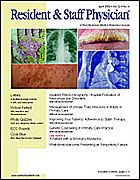Enlarging Ulcer on the Leg
Prepared by Joshua E. Lane, MD, Resident, and Jack L. Lesher Jr, MD, Professor and Chief, Section of Dermatology,
Medical College of Georgia, Augusta
An Asian man with long-standing gastrointestinal complaints had a recurrent leg ulcer that healed poorly. He had been previously diagnosed with inflammatory bowel disease and colorectal carcinoma. Physical examination showed an ulcerated plaque with ragged edges on his lower extremity, suggesting the diagnosis of pyoderma gangrenosum (Figure).
Clinical examination typically reveals rapidly enlarging papules and plaques that form necrotic ulcers with raised violaceous borders and a necrotic base. Biopsy, however, is necessary to exclude other causes. These lesions are often painful and usually appear on the lower extremities.
Systemic corticosteroids are the most common treatment. Other therapeutic options include cyclosporine (Neoral), mycophenolate mofetil (Cell-Cept), other immunosuppressive agents, as well as total colectomy in some cases. Avoidance of surgery is key, because medical management offers the best results.
Points to remember: Pyoderma gangrenosum is an uncommon, chronic, ulcerative disease of the skin associated with inflammatory bowel disease (ie, ulcerative colitis or Crohn's disease). Other systemic associations include arthritis and lymphoproliferative disorders. The 4 major types are ulcerative, bullous, pustular, and superficial granulomatous.
Diagnosis: Pyoderma gangrenosum.
